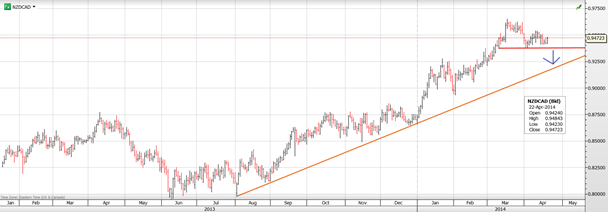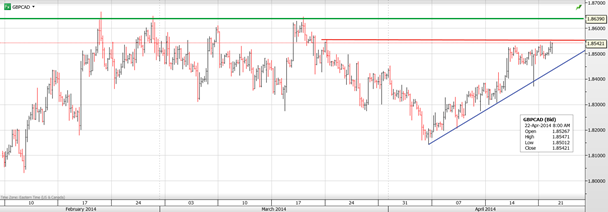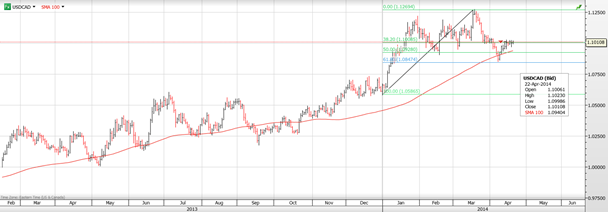• Light week for data from Canada and US
• CAD Cross trading to define direction
• Bank of Canada's focus on inflation
A post-Easter sugar crash may be responsible for lethargic FX markets today with a very light Canada and US economic calendar this week not helping matters. FX traders ignored a report in the Australian Financial Review that Finance Minister Joe Hockley was unhappy with the Reserve Bank of Australia's (RBA) move to a neutral bias and rightly so. Central bankers are notoriously protective of their autonomy and the RBA is no different. USD/JPY is mildly bid as traders warm to the idea that Japan's revamped Government Pension Investment Fund (GPIF) and its new mandate to invest in riskier assets rather than just government bonds will lead to further stimulus from the Bank of Japan and thus a weaker JPY. GBP/USD was the star of the overnight session touching the 2014 highs in part due to the anticipation of hawkish minutes from the Bank of England, due tomorrow.
US Data Releases
FX traders are unlikely to find inspiration from this week's US data releases.
Wednesday: April Markit Manufacturing PMI (Forecast, 56.0); March New Home Sales (Forecast, 450,000).
Thursday: March Durable Goods: (Forecast, 2 percent, ex-transportation 0.6 percent). The risk is that the data will exceed expectations as weather issues dissipate.
Friday: April Reuters/Michigan Consumer Confidence Index (Forecast, 83).
Canadian Data Releases
Wednesday: February Retail Sales (Forecast, 0.4 percent, ex-autos 0.5 percent month-over-month). The headline number is unlikely to beat the 1.3 percent gain in January but a better-than-forecast print would still give the loonie some support.
Loonie in the cross hairs.
The lack of Canadian economic data this week leaves the loonie in the cross hairs and exposed to the ebbs and flows of regional developments dictating direction in CAD crosses. It starts tonight with the Australian CPI data and the HSBC China Manufacturing PMI. A strong PMI reading coupled with a high Australian CPI would give the AUD/USD a boost and is likely to lead to AUD/CAD demand. However, the Reserve Bank of New Zealand (RBNZ) announcement of its interest-rate decision on Wednesday could offset AUD/CAD demand with NZD/CAD selling. An increase of 0.25 percent is fully priced, which leaves the statement to be the source of volatility. If it is perceived to be dovish then NZD/USD will come under heavy selling pressure, potentially benefitting the loonie on the selling of NZD/CAD.

Source: Saxo Bank
Tomorrow's release of the Bank of England minutes also poses some risk for the Canadian dollar. GBP/USD and by default GBP/CAD has been on a tear throughout April and is once again flirting with levels not seen since 2009. The currency is already trading as if the minutes are revealing a more hawkish stance than was previously thought. If so, GBP/CAD risks a return to 1.8670. Conversely, disappointment should see selling of GBP/USD and GBP/CAD.

Source: Saxo Bank
Canadian dollar outlook
There is a strong possibility that the buying and selling of Canadian dollars against the majors will keep USD/CAD in its recent 1.0940-1.1040 range for the balance of the week. As was evidenced last week in the Bank of Canada's (BoC) interest rate statement and Monetary Policy Report, the BoC is pretty obvious with its desire to have a weaker currency. Its governor, Stephen Poloz, is continuing to highlight the risks of deflation even in the face of recent rising inflation data, which is diminishing the effects of the improving domestic data on the loonie.
USD/CAD technical outlook:
The USD/CAD is directionless, hovering just above the middle of the intraday trading band of 1.0940-1.1040. There is a small bullish USDCAD bias while trading above 1.0980 which, if it holds, should lead to another test of 1.1040. A break of 1.1040 would extend gains to 1.1080 while a move below 1.0980 targets 1.0940, which is also the 100-day moving average.

Source: Saxo Bank
